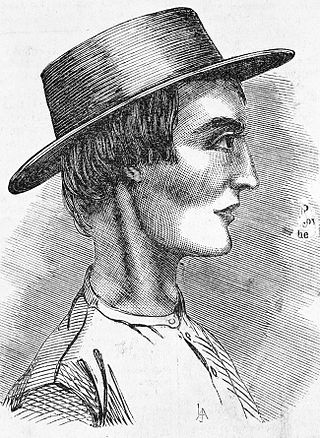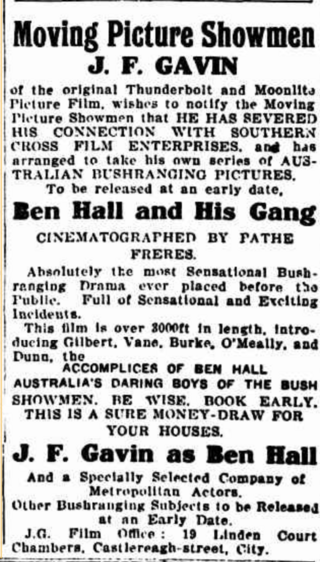
Thunderbolt is a 1910 Australian feature film based on the life of the bushranger Captain Thunderbolt. It was the directorial debut of John Gavin who later claimed it was the first "four-reel movie" made in Australia. It has also been called the first film made in New South Wales.

Smiley is a 1956 British-American comedy film directed by Anthony Kimmins and starring Colin Petersen. It was based on the 1945 novel of the same name by Moore Raymond who co-wrote the film with Kimmins. It tells the story of a young Australian boy who is determined to buy a bicycle for four pounds, and along the way he gets into many misadventures.

John Dunn was an Australian bushranger. He was born at Murrumburrah near Yass in New South Wales. He was 19 years old when he was hanged in Darlinghurst Gaol. He was buried in the former Devonshire Street Cemetery in Sydney.

John F. Gavin was a pioneer Australian film actor and director, one of the early filmmakers of the 1910s. He is best known for making films about bushrangers such as Captain Thunderbolt, Captain Moonlite, Ben Hall and Frank Gardiner. Known informally as 'Jack', Gavin worked in collaboration with his wife Agnes, who scripted many of his films.
The Squatter's Daughter is a 1933 Australian melodrama directed by Ken G. Hall and starring Jocelyn Howarth. One of the most popular Australian films of the 1930s, it is based on a 1907 play by Bert Bailey and Edmund Duggan which had been previously adapted to the screen in 1910.

Moonlite is a 1910 Australian bushranger film about Captain Moonlite, played by John Gavin, who also directed for producer H.A. Forsyth. It was also known as Captain Moonlite and is considered a lost film.

Ben Hall and his Gang is a 1911 Australian film about the bushranger Ben Hall, played by John Gavin, who also directed. It is considered a lost film.
Agnes Gavin (1872–1947), was an Australian actor and screenwriter in the silent film era. She worked in collaboration with her husband John Gavin throughout her career. She wrote the majority of his films and was arguably the first specialist screenwriter in the history of the Australian film industry. In newspapers she was advertised as the "well known picture dramatizer" and was praised for creating "cleverly constructed stories". Many of her films are considered lost.

Frank Gardiner, the King of the Road is a 1911 Australian film about the bushranger Frank Gardiner, played by John Gavin, who also directed. It was the fourth consecutive bushranger biopic Gavin made, following movies about Captain Thunderbolt, Captain Moonlite and Ben Hall.

The Assigned Servant, or the Life Story of a Deported Convict is a 1911 Australian silent film about a convict who is transported to Van Diemen's Land. It was made by the husband-and-wife team of John and Agnes Gavin and is considered a lost film.

His Convict Bride is a 1918 Australian silent film from the team of John and Agnes Gavin. It was a convict-era melodrama.

Assigned to his Wife is a 1911 Australian silent film from director John Gavin. It is a convict-era "military romantic melodrama".

The Digger Earl is a 1924 Australian film comedy from director Beaumont Smith. The plot is about a typical Australian who takes the place of an earl.

Hills of Hate is a 1926 Australian silent film directed by Raymond Longford, based on the debut novel of a similar name by E. V. Timms, who also wrote the screenplay. It is considered a lost film.
When the Kellys Were Out is a 1923 Australian feature-length film directed by Harry Southwell about Ned Kelly. Only part of the film survives today.

The Romance of Runnibede is a 1928 Australian silent film based on an incident in a book by Steele Rudd. Unlike many Australian silent movies, a copy of it exists today.
Robbery Under Arms is a 1907 Australian silent western/drama film based on the 1888 novel by Rolf Boldrewood about two brothers and their relationship with the bushranger Captain Starlight. It was the first film version of the novel and the third Australian feature ever made.
Captain Starlight, or Gentleman of the Road is a 1911 Australian silent film about the bushranger Captain Starlight. It was based on Alfred Dampier's stage adaptation of the 1888 novel Robbery Under Arms. It is considered a lost film.

Dan Morgan is a 1911 Australian film from Cosens Spencer about the bushranger Daniel Morgan. It was said to be starring "Alfred Rolfe and company". Rolfe directed three movies for Spencer, all starring himself and his wife Lily Dampier so there is a chance he may have directed this one and that it starred his wife. A prospectus for the Australian Photo Play Company said he directed it. It is considered a lost film.
Gordon Collingridge was an Australian actor during the silent film era. He played many matinee idol type roles, most notably for director Beaumont Smith and opposite Louise Lovely in Jewelled Nights (1925). Lovely called him "the male screen star to the manner born."














